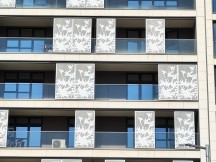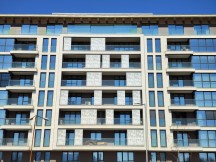Xiaomi 12 Pro review

Triple 50MP rear camera, 32MP selfies
The 12 Pro is equipped with a triple camera on its back, and the basic numbers are easy to remember - all three units are 50MP. Naturally, however, there's more to that.

The primary camera uses a Sony IMX707 sensor, a new imager that debuted on the Xiaomi and was later reportedly featured on the Honor Magic V. In any case, this here is the first time we're seeing it in action. It's a 1/1.28" type unit with 1.22µm pixels and a Quad Bayer color filter array, so you can look at it as a 12.5MP sensor with 2.44µm pixel pitch. It's paired with a 24mm equivalent lens with an f/1.9 aperture, which is stabilized. Some sources even claim it's capable of All-pixel autofocus, but it's hard to tell without a public specs sheet available from Sony.
The other two cameras employ the Samsung JN1 sensor, which too stands at 50MP and has a Tetracell color filter (Samsung's speak for Quad Bayer). This one is noticeably smaller - 1/2.76" type with 0.64µm pixels (1.28µm after the 4-to-1 binning) - so about a quarter of the area of the main one, though still pretty great size for the application.
The telephoto camera has a 48mm equivalent lens giving you a generally unremarkable 2x zoom reach, but it's a pretty bright lens for a telephoto cam - its aperture is f/1.9. It's not stabilized, however.
The ultrawide, meanwhile, is listed to cover a 115-degree field of view and its equivalent focal length is 14mm. What's missing on the ultrawide is autofocus - it's fixed.
Also fixed is the focus of the selfie camera. This one is based on the OmniVision OV32b40 sensor, a 4-cell unit (that's OV's name for Quad Bayer) with a 0.7µm pixel size and 1/3.14" optical format.

The camera app is simple and functional, with some familiar Xioami quirks. First, basic operation for changing modes works with sideswipes (on the black bezel!), and you can also tap on the modes you can see to switch to those directly. Up and down swipes don't work for switching between the front and rear cameras; only the toggle next to the shutter release does that.
You can add, remove, and rearrange modes in the main rolodex by going to the More tab and navigating to the edit button, and you can access that from the settings menu as well. The unused modes will still be in that More tab, but you can switch to a (less intuitive) pull-out pane that's summoned from a line next to the shutter release.
The hamburger menu at the far end of the screen is where you'll find additional options, plus the icon to access the settings. Next to that hamburger menu, you have a flash mode switch, an HDR switch, an AI toggle, a shortcut to Google Lens, and a magic wand with beauty effects and filters.
On the near end, you have the camera zoom switch that operates in one of two fashions. The first one is simply tapping on one of the three dots that represent the ultra-wide, primary, and 2x digital options. Or you can tap on the active magnification and slide sideways to reveal even more zoom levels - 5x, 10x, and 20x, plus a slider for intermediate magnifications.
There's a nicely capable Pro mode, where you can tweak the shooting parameters yourself, and you can use it with all three cameras. You get to pick one of 4 white balance presets or dial in the light temperature with a slider, there's a manual focusing slider (with peaking as an option), and shutter speed (1/4000s to 30s) and ISO control with the range depending on which camera you're using. A tiny live histogram is available, and a toggle for zebras can be found in the hamburger menu.
As expected, there's a host of extra modes, including Long Exposure with its own set of different presets - moving crowd, neon trails, oil painting, light painting, starry sky, and star trails.
Night mode is available on all three cameras, and there's also an Auto Night mode setting in the menu, enabled by default. Another option that caught our eye was Eye tracking focus, also turned on by default.
Daylight image quality
Daylight photos from the 12 Pro's main camera are really good. Fine detail is abundant and is rendered with very sensible processing without signs of excessive sharpening. There's some fine grit in areas of uniform color, but we wouldn't remotely call the images noisy. Dynamic range is excellent, and colors deliver just the right level of pop.









Daylight samples, main camera (1x)
The telephoto maintains that expert-level performance. Its shots have excellent sharpness and detail and nice microcontrast. Its colors can be slightly warmer and more saturated than those of the main camera, though you're only likely to see that in deliberate side-by-side comparisons, while in isolation, you shouldn't have a problem with that. Dynamic range is also great.
The one thing we'd complain about when it comes to this camera is that 2x is simply not a lot of zoom power.






Daylight samples, telephoto camera (2x)
Then again, 5x shots can be quite decent at fit to screen level magnification or for general social media sharing. They don't stand up to pixel-level scrutiny, but that's to be expected.



Daylight samples, telephoto camera (5x)
The ultrawide camera is pretty competent too, almost up to the same standard as the other two. Its photos are very crisp in the center, and even though sharpness does drop towards the sides, it maintains a respectable level for an ultrawide. Dynamic range is a notch below the main camera, if perfectly acceptable still. There are also no signs of purple fringing around contrasting detail, not even in the corners, which is a fairly common sight in ultrawides, cheap or expensive.
We do have to point out one inherent flaw of this module, and it's the lack of autofocus, which limits your options for shooting closeups.









Daylight samples, ultrawide camera (0.6x)
50MP mode on the main camera might be able to reveal a smidge of extra detail, but we wouldn't call that a meaningful improvement worth pursuing. Plus, you're more likely to notice the increase in noise and the more pronounced tendency for exhibiting false color in fine patterns.






Daylight samples, main camera (1x), 50MP
It's a similar story on the telephoto camera, where whatever potential detail advantage you might squeeze is offset by the increase in noise and, really, the 4x file size.






Daylight samples, telephoto camera (2x), 50MP
When it comes to the ultrawide's 50MP images, we wouldn't say we're seeing any extra detail, at which point the mode becomes redundant.






Daylight samples, ultrawide camera (0.6x), 50MP
Low-light image quality
The 12 Pro has an Auto Night mode toggle in the camera settings, which is enabled out of the box. As a result, the phone's low-light photos have Night mode processing applied by default, and the results are, for the most part, identical between the two modes.
It's worth pointing out here that whether you're shooting in Photo mode with Auto Night mode enabled or in the standalone Night mode, the images are captured nearly instantly - there's no lengthy process that takes 3-5-8 seconds to complete, but it's just a quick snap with the speediest of progress indicators around the shutter release button. Only the ultrawide takes a bit longer, but it's still one of the fastest we've encountered.
Another common property of all of the test samples across all three cameras is that they are exposed rather conservatively. There's no dramatic brightening of shadows, so these images could look a little dark if you're used to more substantial Night mode action, though a case could be made that this is the truer, more 'photographic' approach. We'd take a bit of a boost in the shadows.
With all of that as a foreword, low-light photos from the 12 Pro's main camera are very good. The detail is excellent, and the noise is very well controlled. We're seeing pleasing saturated colors and nicely preserved highlights, though the urge remains to bump the shadows slider to the right in post.











Low-light samples, main camera (1x), Auto Night mode
Here's how the scene above looks as captured in the dedicated Night mode. You'll note that if you can spot differences at all, they are minimal.











Low-light samples, main camera (1x), Night mode
The telephoto continues roughly along the same lines. We'd take a bit more light in the shadows, as established, perhaps even a bump in exposure altogether, but other than that, there's little to complain about in these photos. The detail is good overall, better in the well-lit areas, noise is kept in check, and colors are every bit as good as during the day. Overall, a very nice performance, thanks in no small part to the combination of conservative focal length, fast aperture, and relatively large sensor.











Low-light samples, telephoto camera (2x), Auto Night mode
On to Night mode for a bit more of the same.











Low-light samples, telephoto camera (2x), Night mode
The ultrawide brings no surprises then, producing solid, if a little dark output. You'd still be getting respectable dynamic range with decently contained light sources, no loss of color and good detail.











Low-light samples, ultrawide camera (0.6x), Auto Night mode
Predictably, Night mode doesn't change much.











Low-light samples, ultrawide camera (0.6x), Night mode
Once you're done with the real-world samples, head over to our Photo compare tool to see how the Xiaomi 12 Pro stacks up against the competition.



Xiaomi 12 Pro against the iPhone 13 Pro and the Huawei P50 Pro in our Photo compare tool
Reader comments
- AnonD-945330
- 27 May 2023
- kXd
" a few years back we would have complained about a punch hole"...lol..that IS the problem
- Laxochris
- 27 Dec 2022
- Nu6
Every comment here, does not reflect note 12 pro. It's an amazing phone, contact me if u need one from Nigeria.





